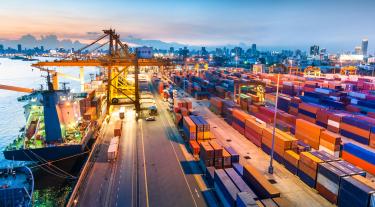After defining an approach to reduce the emissions from your operations , the next step in a low carbon strategy is to work with suppliers to cut their carbon emissions (these are classified as part of a company’s Scope 3 emissions under the GHG Protocol Corporate Standard). For many companies – from food manufacturing to civil engineering and pharmaceuticals – this is where their greatest environmental impact takes place, however, it often starts with difficult conversations.
First, companies that want to address the carbon emissions generated outside their own operations need to shift from the mind-set that, beyond cost, quality and efficiency, what happens outside the enterprise does not matter. Shifting this culture requires effort across many areas including discussions with leaders to staff education programmes.
“You have to go out of a purely linear way of looking at things,” says Eric Soubeiran, global nature and climate director of Danone. “That is, I buy something from a supplier and sell it to a customer. I’m responsible for what happens in between but I don’t know what happens before and I don’t care what happens after – this is changing the way of thinking.”
It also requires conversations with suppliers to explain the changes and the rationale behind them. This is something BT had to do when it introduced specific terms on carbon reduction to its supplier contracts. Huawei was the first supplier to pilot this new contract clause and it did not take long before the Chinese telecoms equipment maker saw the benefits of working with BT on environmental efficiencies.
For example, when BT encourages suppliers to reduce the size of their electronic products, this lowers transportation costs for the supplier. Moreover, working with BT on efficiencies gives suppliers a head start when other customers start asking questions about carbon emissions. “Companies tend to become converted when you start to talk about sustainability,” says Gabrielle Ginér, BT’s head of environmental sustainability.
For this reason, BT set up its Better Future Supplier Forum to share best practice with suppliers and offer training and technical support as they make the transition to low carbon ways of doing business. To put momentum behind the programme, the company assessed each supplier, giving them a rating from bronze to gold. “We wanted this programme to inspire suppliers about sustainability and innovation,” says Ginér.
Verizon also finds the rating system a useful one in bringing suppliers up to speed as they embrace sustainability strategies. The company uses a third-party platform to score its suppliers’ performance in areas such as the environment, as well as fair labour and ethical business practices.
“When it comes to suppliers, particularly outside the US, there can be a lot of opportunities but change can take time, because they’re not governed by the same rules and regulations we have in the US,” says James Gowen, head of its global supply chain operations and chief sustainability officer. “Some have been great, but the conversations aren’t always easy and we need to work with suppliers at all stages of their sustainability journeys to try and move forward together."
When weaknesses are identified, Verizon helps suppliers to create action plans to improve their performance and, in one case, a difficult decision had to be made that resulted in the company walking away from a supplier.
The scale of the challenge
The other big challenge for companies when working with suppliers on carbon reduction is one of sheer numbers. “The first step is trying to understand what our operating baseline is and establishing systems to monitor suppliers’ greenhouse gas emissions,” says Joan Krajewski, general manager of safety, compliance and sustainability at Microsoft. “That may sound simple but when you’re dealing with thousands of suppliers all over the world, it’s not so easy.”
The answer for Microsoft has been to look for help. It asks all its suppliers to report, not to the company itself, but to CDP through its global disclosure system. “This type of information is really valuable to us and provides us with assurance that they’re following best practice with respect to emissions and future opportunity for improvement.”
The company also recognises that many suppliers may need a helping hand, particularly those that have never been through the disclosure process before or that operate in countries where regulatory frameworks on climate change are weak. Microsoft helps them by performing energy audits and helping suggest improvements. “Rather than cutting them off early on, we try to build up their capability and muscle,” says Krajewski.
Mario Abreu, vice-president of sustainability at Tetra Pak says that the company has had similar experiences, with different levels of sophistication in the approach of its suppliers to carbon reduction. “Some were active in looking at carbon and some were a bit unaware of what was happening in their value chain,” he says. “But working with them to understand their carbon footprint led them to make decisions they might not have otherwise have made and to set targets.”
For Microsoft, the benefits of working with suppliers have been encouraging so far. Collectively, the company’s supply chain partners have reduced their carbon emissions by more than five million tonnes year-on-year, or a two per cent reduction.
As Microsoft and others have found, working upstream in the supply chain to address carbon emissions might be challenging, but is an important part of a company’s approach to reduce its impact.
There is also an additional benefit: scrutinising operations for carbon savings turns out to be a good general business discipline, helping identify better ways of doing things. “The lens of carbon impact forces you to analyse your supply chain and ask what can be done better,” says Soubeiran. “It means you look at the business in a different way.”
Read the full series
Part 1 - A time for corporate climate action
Part 2 - First steps in emissions reductions: energy efficiency in your own operations
Part 3 - Big benefits await those who tackle supply chain emissions
Part 4 - New climate opportunities are downstream
Part 5 - Power of the people: engaging your stakeholders on climate change



